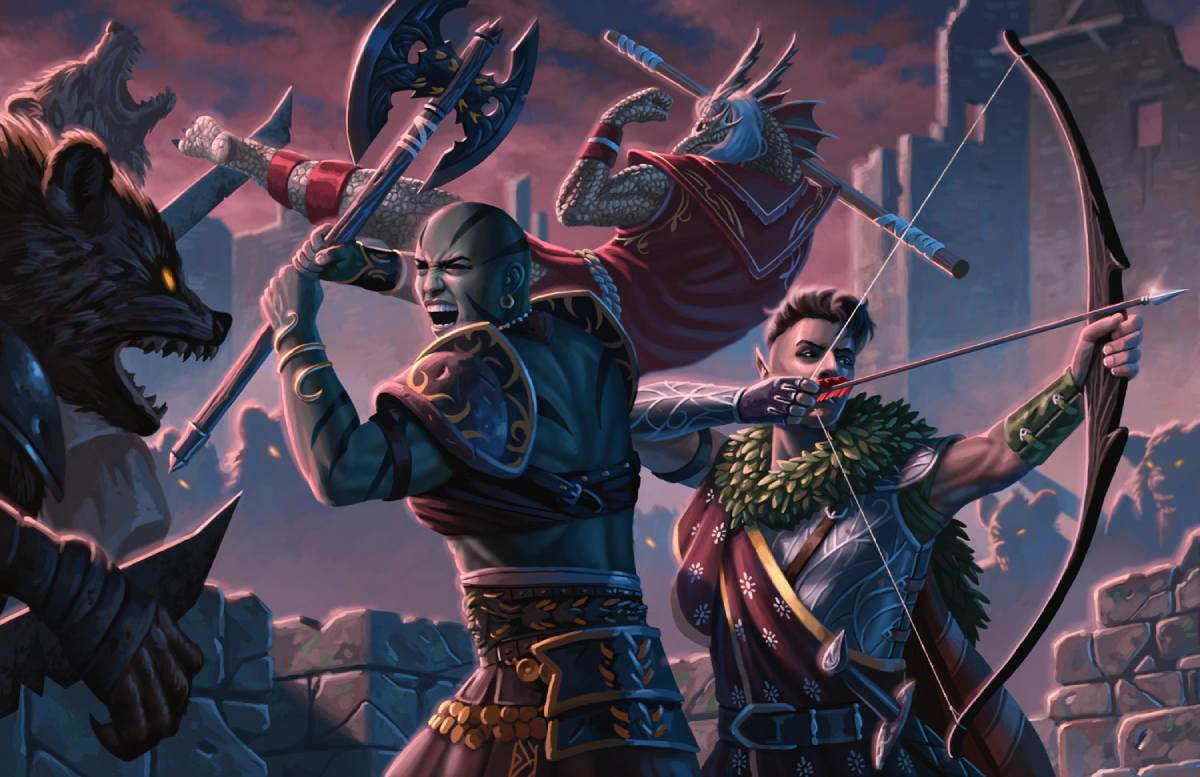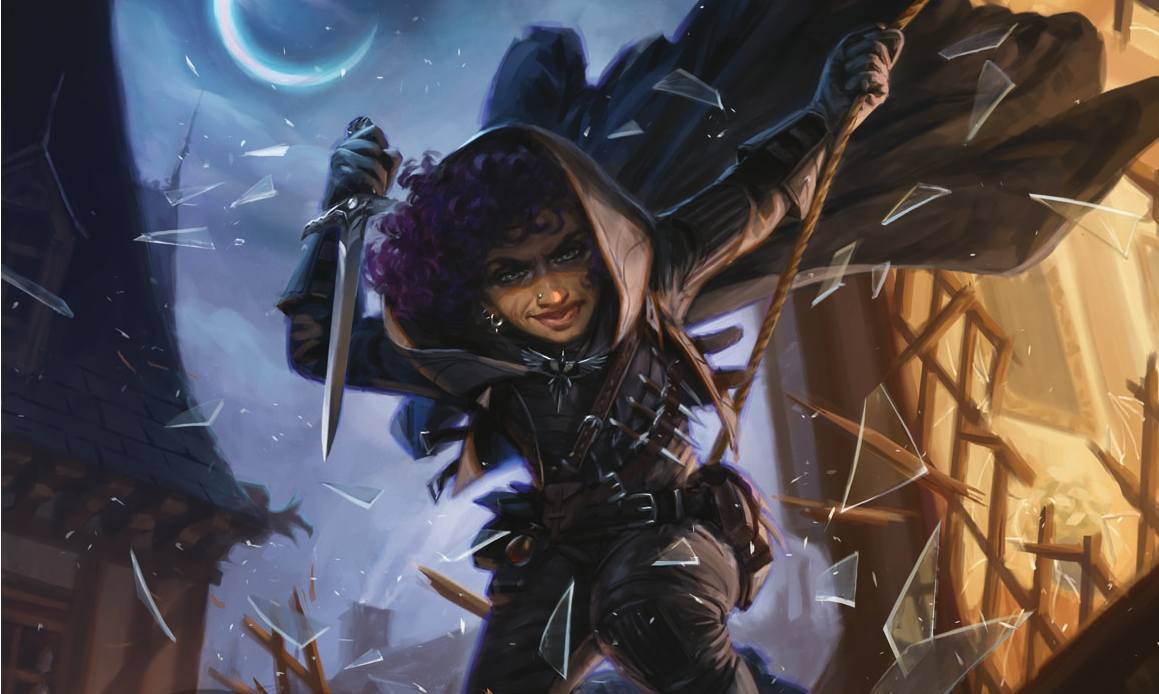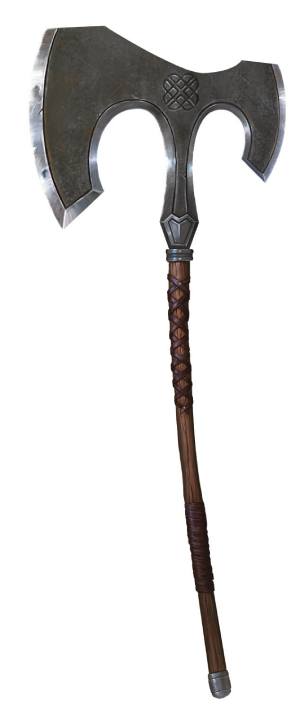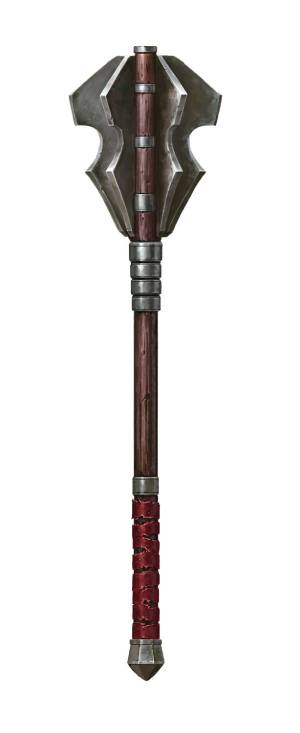The Fighter uses their Maul to knock down their opponent, the Rogue dances around with their Rapier to find their foe’s weak point, and the Barbarian swings a Greataxe through two enemies with a single blow. Every character in D&D has a unique flare they bring to combat, and that’s reflected in the new Weapon Mastery feature in the Player’s Handbook!
Let’s explore these fresh ways to utilize your weapons in the upcoming core rulebook revamp!
Build Your Warrior Today
Start building your weapon-wielding warrior today in D&D Beyond's Character Builder. You can access Weapon Mastery for free using the D&D Beyond Basic Rules, so you can test out this new brand-new system and start cutting a heroic path through your foes!
What is Weapon Mastery?

Weapon Mastery is a class feature shared between some martial classes that reflects their specialization with certain types of weapons.
Each weapon in the Equipment section of the 2024 Player’s Handbook lists a mastery property in addition to the weapon’s regular properties. If the weapon meets the requirements in your class's Weapon Mastery feature, you can learn its mastery property and use it in combat.
But learning a mastery property isn't permanent. If you stumble across a shiny new +1 Longsword and want to learn its mastery properties instead, don’t worry! During a Long Rest, you can practice weapon drills and swap out one of your weapon choices at the end of the rest.
The number of mastery properties you can learn is specified in your class's version of the Weapon Mastery feature. Rogues, rangers, and paladins can only access two mastery properties at a time, whereas barbarians and fighters start with two and three, respectively, and eventually gain access to more mastery properties, as detailed in their Features table.
At level 1, Barbarians, Fighters, Paladins, Rangers, and Rogues get access to the mastery properties for certain types of weapons, as listed below:
- Barbarian: Simple and Martial Melee weapons
- Fighter: Simple and Martial weapons
- Paladin: Based on weapon proficiencies (Simple and Martial weapons)
- Ranger: Based on weapon proficiencies (Simple and Martial weapons)
- Rogue: Based on weapon proficiencies (Simple weapons and Martial weapons with the Finesse or Light property)
Mastering Weapon Mastery
Some subclasses allow you to access more mastery properties. For example, the Soulknife Rogue can use the Vex mastery property with their Psychic Blades and it doesn’t count toward their learned Weapon Mastery limit.
How to Use Weapon Mastery Properties
If you’re wielding a weapon and have learned its mastery property, you’ll be able to use that mastery property every turn when you make an attack with the weapon.
Different mastery properties have different triggers. For example, Cleave requires you to hit a creature with a melee attack roll while Graze triggers when you miss a creature with an attack roll.
Unlike some abilities, there’s no limit to how many times mastery properties can be used per Short or Long Rest, so go nuts!
Mastery Properties Overview

Below, we’ll cover each of the eight mastery properties included in the 2024 Player’s Handbook. We’ll even throw in some tips to help you brainstorm ideas for your new characters!
Cleave

Example Weapon: Greataxe
If you’ll be wading into the thick of battle, you’ll want to consider grabbing a weapon with the Cleave property.
These heavy weapons can slash through opponents. If you hit a creature with a melee weapon attack, you can make a second attack against a creature within 5 feet that is also within your reach. When you hit with the second attack, you can roll your weapon’s damage, but you don’t add your ability modifier unless it’s negative.
This is excellent in combination with the Halberd, which has Reach and Cleave, allowing you to Cleave into enemies in an extended range.
Graze
Example Weapon: Greatsword
Graze is an excellent way to increase the consistency of your weapon damage.
If you miss a creature with your weapon, you deal damage equal to the ability modifier you used to make the roll. This pairs well with abilities that allow you to make a lot of attacks, like the Fighter’s Extra Attacks features or the Polearm Master or Sentinel feats.
It just goes to show that when a weapon is big enough, you don't really need to aim where you're swinging.
Nick
Example Weapon: Dagger
To explain the Nick property, we should briefly cover that being able to attack twice while dual-wielding Light weapons has subtly changed in the 2024 Player’s Handbook. Instead of being covered under Melee Attacks, the rules for dual-wielding Light weapons are covered under the Light weapon property.
It still functions the same way: When you make an attack with a weapon that has the Light property, you can use a Bonus Action to make one attack with a different Light weapon you’re wielding.
The Nick mastery property allows you to make the additional attack you receive from wielding two Light weapons as part of the initial attack action.
Keep in mind that this doesn’t mean you can make a third attack as a Bonus Action, as the Light property specifies you only get one extra attack. But, while it may not pump your damage, this frees up your Bonus Action to use class/species abilities, such as the Rogue’s Cunning Action, while still getting an additional attack in.
Push
Example Weapon: Greatclub
Sometimes giving an enemy a simple shove off a cliff or into a pit of lava is all you need to win an otherwise tough encounter! The Push mastery property allows you to launch a creature you hit 10 feet straight away from you without a save.
Not only is this great when combined with environmental hazards, it's also great for escaping Opportunity Attacks. If you or a less tanky party member are being harassed by an enemy, you can push the enemy 10 feet away, which can allow you to create the space needed to escape unscathed.
Keep in mind that you can only push enemies Large or smaller, so don’t go getting stuck next to an Adult Black Dragon.
Sap

Example Weapon: Mace
If your job is to distract the enemies for long enough to let your blaster caster friends deal with them, Sap is a solid choice.
When you hit an enemy with an attack, this mastery property inflicts Disadvantage on your target’s next attack roll before the start of your next turn.
So, for heavily armored, tanky builds, your enemies will be so focused on trying to take you out that they won’t even see the Fireball coming.
Slow
Example Weapon: Light Crossbow
This mastery property is excellent for fast builds that like to flit across the battlefield. When you hit a creature and deal damage, you can reduce its Speed by 10 feet until the start of your next turn.
This combos excellently with the Light Crossbow, allowing you to take shots, damage your opponents, and then move to just out of range of their reduced Speed. Rinse and repeat until they look like a pin cushion.
It’s important to note that a creature hit more than once by weapons with this property doesn't have its Speed reduced any more than 10 feet. So don’t expect to stand still, hit your enemy three times, and not get caught.
Topple
Example Weapon: Maul
This mastery property is for all those builds that love to wail on their enemies with multiple melee attacks.
When you hit a creature, you can force it to make a Constitution saving throw or fall Prone. The DC for this save is 8 plus the ability modifier used to make the attack plus your Proficiency Bonus.
So, a level 5 Fighter with a Maul could knock their opponent Prone with their first attack, then use their second attack and Action Surge to make multiple attacks with Advantage.
Just remember attacking Prone enemies outside of 5 feet actually gives the attacker Disadvantage on their attack roll. So only use this ability if you or another melee-minded party member can take advantage of it.
Vex
Example Weapon: Shortsword
Having a weapon with Vex feels like a superior swordsman dancing around their opponent, striking at openings until the battle is won.
When you hit a creature and deal damage, this mastery property gives you Advantage on your next attack roll before the end of your next turn. This is an excellent way for Rogues to all but guarantee a Sneak Attack hit on their next turn.
The Student Becomes the Master
The 2024 Player’s Handbook is now available on the D&D Beyond marketplace, which means it's time to set out on new adventures with fresh or familiar characters!
Weapon Mastery is a fun way to give martial characters more choice in combat. It also revamps the way weapons feel in D&D. The new options and revisions presented in this book are a result of a decade of lessons learned and adventures had. With updated rules and streamlined gameplay, it's never been easier to bring your stories to life.
We’re delighted to share with you the changes to fifth edition D&D that appear in the 2024 Player’s Handbook. Make sure to keep an eye out on D&D Beyond for more useful guides on using the wealth of new options, rules, and mechanics found in the 2024 Player's Handbook!

Mike Bernier (@arcane_eye) is the founder of Arcane Eye, a site focused on providing useful tips and tricks to all those involved in the world of D&D. Outside of writing for Arcane Eye, Mike spends most of his time playing games, hiking with his partner, and tending the veritable jungle of houseplants that have invaded his house.
This article was updated on August 12, 2024, to issue corrections or expand coverage for the following features:
- What is Weapon Mastery?: Made clear that the Rogue is proficient with all Simple weapons.
- Slow: Clarified that the Slow property doesn't stack with itself.








-
View User Profile
-
Send Message
Posted Jun 28, 2024I agree. There would be some really cool openings for a "fists" mastery if monks got any mastery uses.
-
View User Profile
-
Send Message
Posted Jun 28, 2024I think the idea is that A: your DM would be smart enough to not give a lvl 20 fighter with graze a Belt of Storm Giant Strength. And B: at level 20, Spellcasters will be pullin shit like true polymorph to turn the tarassque into a bunny rabbit, or casting wish to just will it out of existence. It will help take a a step towards making Fighters somewhat on the same playing field as 20th level Wizard. (Not that the fighter would stand any chance :) )
-
View User Profile
-
Send Message
Posted Jun 28, 2024Yes, they were always cool. But always underwhelming compared to spellcasters. Every single build I've ever played with that has actually consistently outputting damage has had some sort of spellcasting to help me.
-
View User Profile
-
Send Message
Posted Jun 29, 2024if you are replying to me then, I was trying to say that the foe will be forced to move by me (:
-
View User Profile
-
Send Message
Posted Jun 30, 2024If I have an extra attack and I am using daggers, and I have the nick ability, I can make 3 attacks, right?
-
View User Profile
-
Send Message
Posted Jun 30, 2024Not confirmed for final version yet, but UA7 shows that Whip has "Slow", is complimentary to the "damage at 10 foot range" a Whip does... but I feel like Topple is a much more iconic Whip move. Yes, that does mean that if you Topple them with your first attack, you'll have disadvantage with the 2nd because you're 10 feet away, but I'm okay with that.
-
View User Profile
-
Send Message
Posted Jun 30, 2024so would the light weapon act exactly the same way a bonus action would act and refresh at the beginning of your turn. or could you make 4 attacks while dual wielding with extra attack.
-
View User Profile
-
Send Message
Posted Jun 30, 2024The way Crawford described it in the video, it allows you one additional attack with the weapon in your other hand, the same way that Two-Weapon Fighting normally does, it just doesn't use up the bonus action to do it. So, if you have two attacks per action, you could make a total of three attacks in a turn if you were dual-wielding weapons with the Nick property.
-
View User Profile
-
Send Message
Posted Jul 1, 2024So this is more like weapon attunement than mastery of something like a fighting style? Like you can learn the mastery of something that is a weapon you're already proficient in rather than choosing during character creation to have mastery over something like Longswords and Hand axes? That could be interesting but I do think Push should have a DC similar to Topple. This is clearly BG3 inspired, which isn't a bad thing, but there is no reason not to balance them in the same way otherwise you're going to end up with martial players pushing things in and out of hazards completely uncontested.
-
View User Profile
-
Send Message
Posted Jul 1, 2024I still think GRAZE is OP. unlike TOPPPLE which scales down with increased monster CR. At low levels TOPPLE really shines but at high levels the chance that a High CR monster will fail a Constitution Saving throw is small. Even if there is a small chance the added damage isn't very much. This is kind of how GRAZE should be, great at low levels but not very helpful at very high levels.
-
View User Profile
-
Send Message
Posted Jul 1, 2024Graze is okay, what are the chances that characters with enhanced str due to belts actually miss?
-
View User Profile
-
Send Message
Posted Jul 2, 2024Is it intentional for dual wield + polearm mastery to pick up two extra hits instead of one?
hit with dual wield weapon (nick)
use free extra attack from nick
swap to polearm and attack
then use bonus action from polearm
-
View User Profile
-
Send Message
Posted Jul 2, 2024No, because (at least under the current rules) Polearm Master requires you to take the Attack action to attack only with a polearm before you get that extra bonus action attack. You can't attack with something else and then swap to the polearm. The idea is that the bonus action attack is made as part of the same move with the polearm.
-
View User Profile
-
Send Message
Posted Jul 3, 2024How does Nick work with Multiple attacks? If you are a lvl 5 fighter with two attacks, do you get 4 if they are light with the nick property?
-
View User Profile
-
Send Message
Posted Jul 3, 2024No, you'd only get 3. Two-weapon fighting only gives you a single attack with the second weapon as a bonus action. This works exactly the same way, except you don't use up your bonus action to do it. This is called out explicitly in the video.
-
View User Profile
-
Send Message
Posted Jul 3, 2024I wonder taht property the rapier will have , haven't found that anywhere 🤔
-
View User Profile
-
Send Message
Posted Jul 5, 2024I'm wondering what other peoples opinions are on this. Since Cantrip damage is 1dx and increases to 2dx at 5th Level, 3dx at 11th and 4dx at 17th. Should a Martial Character, Especially a Fighters, weapon damage increase as well. Cantrips are an unlimited resource. Why is it that as a single attack with a weapon, a Wizard is potentially just as likely to hit and do the same damage with a dagger as seasoned Fighter? Multiple Attacks keeps them even with damage at best.
-
View User Profile
-
Send Message
Posted Jul 5, 2024Most cantrips don't allow you to use your Intelligence bonus modifier for damage. Evoker Wizards can add it once per dice but that is a special ability for the Evoker subclass.
So a Fighter at 20 lvl with 20 STR with Duelist Fighting Style could do .05*(4.9*2+5+2) + .6*(4.5+5+2) = 7.7 ~7
A typical spell caster with 20 INT could do .05*(8*5.5) + .6*(4*5.5) = 15.4 ~15
However a lvl 20 fighter has 4 swings with their weapon per attack action so 7.7 *4 = 30.8 ~30
So a fighter is doing 2x the damage a caster is doing.
Evoker caster with 20 INT could do .05*(8*5.5+5)+.6*(4*5.5+5)= 18.65 ~18
Still not as good as 30.
If the Fighter uses a weapon with the NICK weapon mastery property with a 20 STR the will do a minimum amount of damage of 20 so still more than a caster and they have missed with their weapon every single time.
I am assuming a 19 AC for the monster.
EDIT: A Warlock using Eldritch Blast plus Agonizing Blast is the exception.
.05*(2*5.5+5)+.6*(5.5+5) = 7.1 but you get for separate blasts so 7.1*4=28.4 ~28
-
View User Profile
-
Send Message
Posted Jul 7, 2024Does each hit trigger the weapon mastery effect? If I hit someone once or twice with the push weapon, do they move 10 feet with each hit?
-
View User Profile
-
Send Message
Posted Jul 8, 2024I believe that yes, weapon damage should increase as well, but not as fast as the cantrips, because casters can only cast 1 of those a round while martials can often make multiple attacks with weapon each round. I feel the addition of Weapon Mastery is a great opportunity that is not being fully taken advantage of. In my game, if you have Mastery in a weapon, it will give you some benefits immediately, and more at 11th level. I have to read all the changes in the new PHB, but my current thought is that if you hit a target with a natural 18 or 19, you'll roll 2 weapon damage dice instead of 1 (so 2d8 with a longsword). If you get a nat 20, you get 1 maxed damage die and also roll 1 more (So 1d8+8 with a longsword). At 11th level, the number of weapon damage dice are doubled for all your Mastered weapons (So any hit with a longsword does 2d8, 18/19 hits are 4d8, and a nat 20 is 2d8+16.)
These rules, combined with the additional number of attacks that many martials are able to make in a round, feels more balanced to me. And it brings back some of the thrill of rolling an 18 or 19 that I remember in the 3.5/PF1 days with weapons that had a higher threat range. I really feel this should have been in the rules as written, but I guess no one thought of doing it, or figured the multiple attacks + mastery properties was enough to make up the difference?